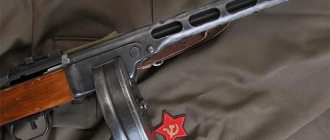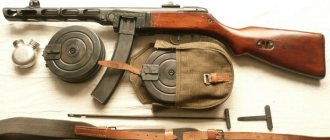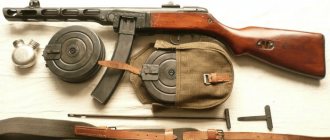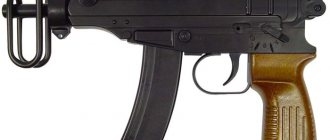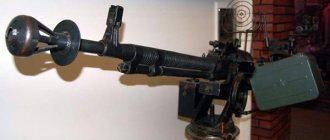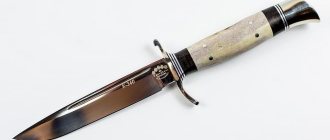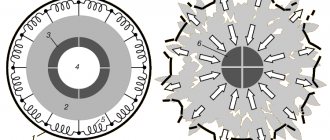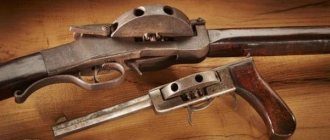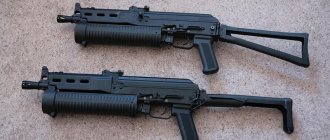Mass produced weapons. Shpagin PPSh-41 submachine gun
Less than five months had passed since the German invasion of the Soviet Union, mass production of the submachine gun began, which was eventually produced in quantities of more than five million copies, and undoubtedly became the most famous Soviet submachine gun of World War II : PPSh-41.
The creator of PPSh, Georgy Semyonovich Shpagin, was born in 1897 into a peasant family in the village of Klyushnikovo. From 1916 to 1920 he served as a gunsmith in an infantry regiment. After demobilization, he found work in the design bureau of an arms factory in the city of Kovrov (let us clarify that in 1916 G.S. Shpagin was drafted into the tsarist army and sent to regimental weapons workshops; after the revolution, he joined the Red Army, where from 1918 to 1920 g. served as a gunsmith in a rifle regiment, and after demobilization he entered the experimental workshop of the design bureau of the Kovrov Machine Gun Plant. - Translator's note). This step determined the direction of his future activities, since his leader was, no more and no less, the famous weapons designer Vasily Alekseevich Degtyarev (in 1920, V. A. Degtyarev headed the experimental workshop of the PKB of the Kovrov Machine Gun Plant. - Translator's note). Subsequently, Shpagin participated in the work on machine guns and developed a carriage for placing a machine gun in a tank (a ball mount for mounting a 6.5-mm coaxial light machine gun of the Fedorov-Shpagin system in a tank. - Translator's note), improved existing machine guns and, among other things, designed a belt feed mechanism for a large-caliber 12.7-mm Degtyarev machine gun with cartridges fed from a disk magazine, which was then renamed “DShK model 1938” (Degtyarev-Shpagin). Along with this, he began designing a submachine gun.
Designer of the Soviet submachine gun PPSh-41 Georgy Semenovich Shpagin (1897–1952). Unfortunately, the original article in the German edition of DWJ shows a photograph of the Soviet small arms designer Sergei Gavrilovich Simonov (1894–1986).
In the Soviet Union, the development of submachine guns began in the mid-1920s, but due to the conservative views of the generals, it proceeded rather sluggishly. Already at the beginning of 1939, after the production of less than 5,000 copies, the production of Degtyarev PPD submachine guns of the 1934 model, which began in 1935, was stopped and all already manufactured weapons entered warehouses. It took the bitter experience of the Soviet-Finnish Winter War for the generals to recognize the need for such weapons. Thus, in 1940, it was decided to begin production of improved models of Degtyarev PPD arr. 1934/38 and PPD arr. 1940
PPD submachine guns were very popular among the troops, primarily due to the large supply of cartridges in the drum magazine, which could hold 71 rounds. But despite numerous design changes, Degtyarev’s submachine guns required large material resources and time during production, and production could not cover the ever-increasing demand.
Although the PPD models were reliable and also very popular among the troops, they were complex and also expensive to produce.
Shpagin's chance
On August 26, 1940, Shpagin’s hour struck: he was able to present to the Artkom GAU (Artillery Committee of the Main Artillery Directorate) a prototype of his submachine gun, developed at that time. In his design, he summarized the experience of the war with Finland and deliberately paid attention to making it as simple as possible.
After numerous tests of prototype weapons, in November 1940, extensive comparative firing of the newly developed weapons took place: 25 Shpagin submachine guns against 15 Boris Gavrilovich Shpitalny submachine guns, as well as for comparison several Degtyarev models already adopted for service. Despite the fact that Shpitalny’s weapon was able to show lower dispersion and higher initial velocity, Shpagin’s weapon was captivating due to its simple handling, lighter weight of 3.5 kg and technological advantages in manufacturing. Probably, the last of the above was then of decisive importance, since the production time of the Shpagin submachine gun - 5.5 hours - was only half of the production time of one PPD-40 submachine gun.
Complete disassembly of the PPSh-41 submachine gun with a drum magazine. The production of one type of weapon required only 5.5 hours. Photo: C&Rsenal channel
On December 21, 1940, Shpagin’s development was adopted by the Red Army as a new standard submachine gun under the official designation “7.62 mm Shpagin submachine gun mod. 1941."
PPSh-41 early release with a sector sight with a range from 50 to 500 m and an unprotected front sight. Later versions of the PPSh-41 had a flip-up sight at ranges of 100 and 200 m
The small town of Zagorsk, located only a few hours away from Moscow by car, was chosen as the location for production. There, mass production began in October 1941, that is, just a few months after the German invasion on June 22. Soon, the completely unexpected successes of the German army showed that the choice of location was unsuccessful and there was a danger that the city could be captured in the foreseeable future. Therefore, there was an urgent evacuation of the enterprise to Vyatskie Polyany (Eastern Urals), very close to a large arms factory in Izhevsk.
The technologically advanced PPSh-41 submachine gun quickly began to be produced in large quantities and, thus, despite the evacuation of production workshops away from the retreating front, over 92 thousand units were delivered by the end of 1941 alone. The following year, production increased to almost 1.5 million, and by the end of the war the total number of copies produced reached 5 million.
Soviet PPSh-41 submachine gun of 7.62x25 caliber with an attached drum magazine for 71 rounds, as well as an underlying box magazine holding 35 rounds
PSh-41 caliber 7.62×25
The submachine gun operates due to the recoil of the free bolt, which is located on the sear in the rear position before the shot, the rollback of which is slowed down by a buffer. The replacement firing pin is rigidly fixed and its firing pin protrudes outward from the bolt mirror. The shooting mode can be selected using a slider located directly in front of the trigger. If it is moved back, a single firing mode is provided; if you move it forward, you can fire in a continuous burst. The weapon feels good in the hands, despite the high rate of fire of almost 1000 rounds per minute. The front, beveled part of the barrel casing serves as a compensator. The trigger mechanism has no warning. A simple slide at the top of the cocking handle serves as a safety feature, both in the cocked state and in the forward position of the bolt.
The submachine gun can be fed from a drum magazine that holds 71 rounds, or from a later developed box magazine that holds 35 rounds. Although drum magazines were popular due to their capacity, they had the disadvantage that they were rather slow to reload in battle. By the way, they were not interchangeable with the PPD-40 magazines.
Aiming was carried out through a reversible sight at 100 and 200 m, and for early production submachine guns - through a sector sight with settings from 50 to 500 m. During production, various design improvements were made: the initially uncovered front sight began to be provided with a riveted fuse made of strip sheet steel, the barrel began to be chrome-plated, and the bolt buffer was made of less expensive material (the front sight fuse was first spring-loaded, and then attached to the barrel casing by spot welding. - Translator's note). Cleaning accessories were placed in the cavity of the PPSh-41 butt.
The butt contains: a dismountable cleaning rod, a screwdriver and a cleaning cord. An oil can with two compartments is carried in a pouch
Disassembly is very simple: you need to press the latch located at the rear end of the receiver, and, pressing the casing above the muzzle of the barrel, turn the receiver. Then pull the bolt back a little and pull it up along with the recoil spring and buffer.
After pressing the spring-loaded cap at the end of the receiver, you can tilt it up
However, the simple design also had hidden disadvantages: the most significant of them was insufficiently reliable protection. There was always a danger of an accidental discharge due to a strong shock or fall of the weapon. If the screws of the trigger assembly are loosened (the author probably means the tail rotor that connects the trigger box to the stock. - Translator's note), the bolt will no longer be cocked, so the weapon will fire continuously until the magazine is used up . Drum magazines also often could not bear the load. The operation of the internal mechanism could easily be blocked by dents.
The only safety mechanism consists of a slider on the cocking handle.
Unlike the Western warring powers, in the Soviet Union submachine guns became the main weapon of the infantry - a circumstance that the Wehrmacht painfully felt. The German MP40 submachine gun could have been exactly the same, but with its 32-round magazine, at decisive moments it was still inferior to the PPSh-41, equipped with a 71-round drum magazine. The rest was completed by a large number of Russian riflemen armed with submachine guns. Accordingly, captured PPSh-41s, which were designated MP 717® in the Wehrmacht, were popular and very rarely transferred to collection sites for captured property. There were even attempts to convert the PPSh-41 submachine gun to chamber a 9x19 caliber cartridge. To do this, a new barrel and a stamped sheet steel adapter for the magazine receiving window were needed in order to be able to attach the box magazine from the MP40.
Most PPSh-41s of a later production period are equipped with a reversible sight, as well as a protected front sight
Further developments
In February 1942, Shpagin presented to the Artillery Committee a version of his submachine gun, specially modified for tank crews and paratroopers, in which the wooden stock could now be detached. But the advantage was negated by unreliable fastening and increased weight. The weapon was rejected. Another alteration was needed. Shpagin presented the result already in May of the same year: the PPSh-42 submachine gun.
Its main feature is a rectangular receiver stamped from steel sheet, complemented by a detachable wooden butt or a metal folding shoulder rest. The simplified trigger mechanism allowed only continuous firing; otherwise, the internal structure of the weapon did not differ from the PPSh-41 submachine gun.
The safety consists of a long dust cover located on the side with cutouts for the cocking handle. If the lid covers the groove of the box, then it blocks the cocking handle in one of the cutouts depending on its position. Despite the fact that the PPSh-42 submachine gun made a good impression during tests conducted from May 30 to June 2, it only took second place. The design of Alexey Ivanovich Sudaev won. His PPS-42 submachine gun was also easy to manufacture and had reduced dispersion. To be more confident, military tests of a small series of 250 PPSh-42s were also carried out, but the decision did not change anymore.
Shpagin's improved model arr. 1942 was manufactured for military trials in quantities of only 250 pieces
As an experiment, the PPSh-41 submachine gun was even used as an on-board weapon on an aircraft: in 1944, the Tupolev Design Bureau experimented with installing submachine guns for firing at ground targets. Therefore, several Tu-2Sh type bombers received a platform with 88 submachine guns installed in the bomb bay. The submachine guns were pointed downwards at an angle of 45o, each was equipped with a conventional drum magazine for cartridges and they could only fire at the same time. But it turned out that the ammunition capacity of the drums (71 rounds each) was too small, and reloading in flight was impractical, so the project was closed.
After the end of the war, Shpagin experimented with curved barrels to better protect the tank from attacking infantry. Probably, his prototype was the curved barrel developed for this purpose (curvilinear barrel attachment. - Translator's note) for the StG 44 assault rifle. Shpagin also bent the barrel along with the casing by 30o. Otherwise, the design of the weapon remained unchanged and nothing is even known about a special sight. However, the tests were clearly unsatisfactory: the greatly reduced muzzle velocity and large dispersion at ranges of up to 50 m led to the cessation of work.
Group photo with submachine guns PPSh-41 and PPS-3
The activities of G. S. Shpagin were highly appreciated. For the submachine gun and various other developments, such as the illumination pistol, he was awarded numerous high awards: the title of Hero of Socialist Labor, the Stalin Prize of the second degree, three Orders of Lenin, the Order of Suvorov of the second degree and the Order of the Red Banner. After the war, due to serious health problems, G.S. Shpagin parted with his professional activities, but he spent the rest of his life in the city of Vyatskie Polyany. There, on February 6, 1952, he died at the age of 56. Today he rests at the Novodevichy cemetery in Moscow.
Production of PPSh-41 submachine guns in Russia ended soon after the war. Since December 1959, a new generation of weapons began rolling off the assembly line in Vyatskie Polyany - Mikhail Timofeevich Kalashnikov's RPK machine gun.
Foreign copies
In other communist countries, copies of the PPSh-41 remained in production for a long time. In 1950, China began its own production of a copy called the Modell 50, Poland began production in 1952, and North Korea only in 1955.
In Yugoslavia, the design underwent extensive processing, so that the weapon manufactured at the Zavodi Crvena Zastava plant in the city of Kragujevac in the form of the Modell 49 sample had only an external similarity with its prototype. For example, the receiver was no longer hinged; now for disassembly it was necessary to unscrew the cover from the back. The characteristic barrel casing became cylindrical and had many small holes for cooling. However, box magazines remained interchangeable.
In a slightly modified form with milled parts, the PPSh-41 was copied by the Croats and was produced as a 9x19 caliber Šokac submachine gun from 1991 onwards during the Yugoslav War.
The author expresses gratitude to Alexander Yushchenko and the C&Rsenal channel for the photographs presented.
Michael Heidler Translation by Nikolai Yezhov
Flaws
Although the Shpagin PP was a leader in many respects, it was still intended primarily for infantry. For the rest of the troops, the designers invented other, more convenient for them, machine guns.
The Shpagin submachine gun was a real find for the Soviet army at that time. War was approaching, and a weapon was needed that was easy to use and versatile, had high performance, low cost and ease of production. The PPSh assault rifle turned out to be just like that. Its technical performance was excellent, and it did not require special equipment or knowledge when creating it. That is why as many as 6 million copies ended up in use by the Red Army. Even the Nazis appreciated the PPSh assault rifle. They could not ignore the technical characteristics. Weapons were the most coveted trophies on the battlefield. Interestingly, the Nazis preferred a disk magazine.
During the Great Patriotic War, PPSh-41 was the most popular and famous submachine gun in the USSR. The creator of this legendary weapon, which the soldiers lovingly called “daddy,” was the gunsmith Georgy Shpagin.
Creation Story
Submachine guns (we sometimes call them machine guns) appeared during the First World War, together with tanks, chemical weapons and machine guns. The last type of weapon, although it was known earlier, its finest hour was specifically the 1st global war. And if the machine gun was an impeccable defensive weapon at that time, the submachine gun was developed as a new offensive type of weapon.
The first drawings of a rapid-fire gun chambered for a pistol cartridge of a huge caliber appeared back in 1915. According to the developers' plan, this weapon was supposed to assist the advancing troops, because it was distinguished by its high rate of fire and maneuverability. Machine guns of that time had impressive dimensions; moving them along with the advancing troops was problematic.
Drawings of such a weapon were developed in almost all countries: Italy, Germany, the USA and Russia, but submachine guns were not able to have a particular impact on the finale of the conflict. But the period of time between the two global wars became the true era of the heyday of this small arms.
There were two concepts for using machine guns. According to the first, the submachine gun was a smaller and lighter analogue of an ordinary machine gun. It was often equipped with a bipod, a long replaceable barrel, and sights that allowed it to shoot at several hundred meters. A common example of such use was the Finnish Suomi assault rifle, which was well used by the Finnish army in the war with the USSR.
Another concept was to arm auxiliary units, fighters of the 2nd lane, and officers with submachine guns, in other words, machine guns were considered as an auxiliary weapon, a possible replacement for a pistol.
custom_block(1, 8166095, 3671);
In the USSR they adhered to the second point of view. The development of submachine guns began in the mid-20s. The 7.63×25 Mauser, with a bottle-shaped cartridge case, was chosen as the cartridge for the future machine gun. In 1929, a competition was announced to develop a new weapon. The country's best designers began to prepare drawings, among them was Vasily Alekseevich Degtyarev, whose submachine gun was adopted for service in 1934.
They began to produce it in relatively small quantities; the Russian military administration at that time considered machine guns only an auxiliary, police weapon.
This worldview began to change after the unsuccessful Finnish campaign, in which Finnish troops successfully used submachine guns. The rugged terrain was perfect for introducing automatic weapons. The Finnish Suomi submachine gun made a huge impression on Russian military leaders.
The Russian military administration took into account the experience of the Finnish war and decided to create a new submachine gun chambered for the same Mauser cartridge. The development was entrusted to several designers, among them was Shpagin. They were entrusted with creating a weapon no worse than the Degtyarev assault rifle, but at the same time significantly simpler and cheaper. After reviewing the drawings and conducting tests, the Shpagin assault rifle was found to meet all requirements.
From the first days of the war, it turned out that this weapon was very excellent, especially with a high density of artillery and mortar fire, in close combat conditions. But there were very few of these weapons in the warehouses of the People's Commissariat of Defense. The large-scale creation of the PPSh-41 was launched at several factories; by the end of 1941 alone, more than 90 thousand PPSh-41 units were produced, and during the war years, 6 million machine guns were produced.
The simplicity of the design and the wealth of stamped parts made the PPSh-41 very cheap and easy to manufacture. This weapon was very effective, had the highest rate of fire, good accuracy of fire and the highest reliability.
custom_block(5, 4217374, 3671);
The 7.62 mm cartridge had the highest speed and excellent penetration capabilities. In addition, the PPSh-41 had amazing survivability: more than 30 thousand bullets could be fired from this gun.
But the most important thing in wartime criteria was the simplicity of this weapon. PPSh-41 consisted of 87 parts; it took only 5.6 machine hours to create 1 product. The PPSh-41 only achieved precise processing on the barrel and partly on the bolt; all other elements were produced using stamping.
Reasons and process of creation
Drawing conclusions from the Soviet-Finnish War (1939 - 1940), the leadership of the USSR gave the order to develop a modern and technologically advanced submachine gun (PP). The new weapon was supposed to match the combat characteristics of the PPD-34/40 (Degtyarev PP), but be easier to manufacture.
By the fall of 1940, G. Shpagin and B. Shpitalny presented their projects to the commission of the People's Commissariat of Armaments.
At the end of November, the Shpagin design bureau produced 25 products, the Shpitalny design bureau produced 15 units intended for testing tactical and technical characteristics. Along with the presented samples, PPD-40 also took part in the tests.
By the end of the tests, the commission concluded that the Shpagin submachine gun was more suitable for the needs of the Soviet armed forces. Since it has better reliability, its parts are less susceptible to wear, with a mass equal to the PPD, it is easier to manufacture, and is not much inferior to the Shpitalny PP in accuracy and magazine capacity (but it weighs 1.5 kg more).
As a result, in December 1940, a decree was signed on the adoption of Shpagin's software and the start of its production. The project presented by Shpitalny was sent for revision, citing the low reliability of the automation.
Receiver
This element is the base. It contains the following details:
Namushnik with a front sight.
Receiver box latch.
Swivel swivel.
The front part of the receiver serves as a casing, and the rear part serves as the bolt box cover.
In general, the receiver consists of:
The base of the front sight for attaching a fly-mount to it.
Swivels for attaching a shoulder belt.
Sight pads.
Inserts for guiding the barrel.
Front inclined plane of the casing. It is a muzzle brake.
Longitudinal cutouts on the casing. This is to improve and facilitate air circulation.
Windows in the muzzle brake area to provide exit for powder gases.
Transverse hole for the connecting axis.
Window for ejection of cartridges.
Latch spring stop.
Bottom ledge. This is to limit the drop in the rear receiver area.
Cutouts for fuse.
Two side ledges (to limit the movement of the latch).
Cutout for the bolt handle.
History of PPSh during World War II
The Shpagin submachine gun, also known as PPSh-41, became the most common automatic personal weapon of soldiers of the Red Army (Workers' and Peasants' Red Army).
It was distributed in various branches of the military: infantry, guards units, airborne groups. It was also actively used by partisans operating in German-occupied territory.
The ROA (Russian Liberation Army) of Vlasov also had their own PPSh.
Ease of use made it possible to reduce the training period for recruits
And this is important in conditions of hostilities
Taking advantage of the high rate of fire, they suppressed enemy soldiers with fire, which left them no chance to survive.
He performed well in urban battles. The Battle of Stalingrad can be called the baptism of fire for this weapon. The fierce battle for the city took place in densely built conditions and numerous confined spaces.
In this kind of battle, the main thing is the rate of fire and the ability to suppress the enemy with continuous fire. The same thing happened in Kharkov and in the spring of 1945 in Berlin.
Design
It is a “PPSh” automatic firearm. It is designed for firing in bursts and single shots. Automation works due to free recoil of the shutter
This is an important property in this case. In other words, reloading and extraction of the cartridge case occurs after the shot due to the return of the loose bolt
Fire is fired from the rear sear, that is, before the shot, the bolt is in the rear extreme position. Then, after descending, he goes forward, after which he fires the cartridge. The primer is pierced at the moment the last process is completed. The shutter does not lock during firing.
This scheme is often used in the development of devices such as submachine guns. For example, the Israeli-made Uzi works on a similar principle. Although absolutely simple, such a solution requires the use of a massive bolt, which increases the entire mass of the weapon. In addition, a weapon that uses a similar reloading scheme can fire due to a strong blow, for example, when falling. If, due to an impact, the bolt rolls from the front extreme (unfixed) position along the guides further than the cartridge feed window from the magazine or from the rear extreme position, it will break off the stopper.
As in Degtyarev’s weapons, such a device as the PPSh assault rifle has: a receiver, which is fused with the barrel casing, a free massive bolt with a safety lock on the loading handle, and a disk magazine. He also has a wooden stock. But with all this, the PPSh-automatic is more technologically advanced. In this model, only the barrel needs precision mechanical processing, and the bolt was made on a lathe with further rough milling. In weapons such as the PPSh (automatic machine), the production of almost all other metal parts can be done by stamping. Here, the barrel casing has a recoil compensator at its front end. That is, in this case there is a beveled plate with a hole for the bullet to pass through. There are through windows on the sides of the casing. Thanks to the reactive action of powder gases when fired, they significantly reduce the effect of recoil and “lifting” of the barrel upward. The scope of this model has only 2 positions. Namely, 200 and 100 m. Since 1942, “PPSh” began to be equipped not with a disk magazine, but with a sector (box-shaped) magazine for 35 rounds.
This was dictated by certain conditions. Namely, the fact that disk-type stores were complex to produce and less reliable. They also demanded adjustments for a specific instance of the machine gun. That is, this part from another similar “PPSh” might not fit. Judging by military photographs, box-type magazines have been seen in troops only since 1944. Next, we will consider the device of the PPSh machine gun in more detail.
Ammo
Initially, the PPSh-41 was equipped with a disk magazine, the same as that of the PPD-40. Its capacity was 71 rounds. This was almost the most expensive part of Shpagin’s submachine gun. It consisted of a magazine box, a drum and a snail. In combat, it is not possible to carry a disk magazine in your hands, so for this purpose a special eyelet was created, which helped attach it to the belt. The cartridges were placed in two rows or streams inside and outside the snail. Thanks to the spring, it rotated. After the outer row of cartridges ran out, the inner row was squeezed out using a feeder.
The downside was the long process of loading the magazine, which was impossible in combat conditions, which is why the soldiers carried spare magazines. Then, however, box-shaped ones began to be used, which were more convenient and cheaper, but only since 1944. Such stores had only 35 rounds, but were supplied with new ones much faster. The caliber of the cartridges was either 7.62 mm or 7.62x25 mm.
